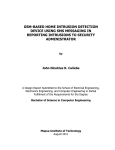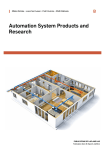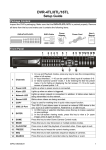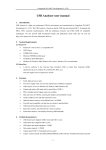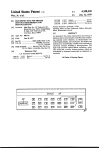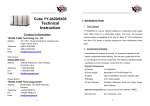Download Article
Transcript
IJIRST –International Journal for Innovative Research in Science & Technology| Volume 2 | Issue 01 | June 2015 ISSN (online): 2349-6010 Automated Security System using ZigBee Sneha Susan Abraham Saveetha School Of Engineering, Saveetha University Abstract Nowadays, Wireless Security Monitoring System is one major research topic in field of Intelligent Buildings. In this paper, we present a Wireless Home Security System Using ZigBee. Rather than using the traditional method to implement the real-time surveillance of the home security; the system was developed using ZigBee for the wireless connectivity. The system can set the alarm, Open the Door and Close the Door. The Hardware and Software and working of the system are explained in detail. A number surveillance device can be connected for further improvement of the system. Keywords: Wireless Security System, ZigBee Module, Digital Door Lock, Human Detection Module, ZigBee Relay Module, Motion Sensor _______________________________________________________________________________________________________ I. INTRODUCTION Home Security System is a system used to protect our home from intruders, theft i.e. system used to keep our home safe & secure. There are two methods for home networking system:-(i) Conventional method i.e. wired.(ii) Un-conventional method i.e. wirelesses. Compared to wired system, wireless system provides more flexibility, extensibility and is free from construction works. In this system design the wireless technology which is used is ZigBee. This is an electronic locking system operated by the combination of digital key, security password or number code.To implement this system we use ZigBee module which will furnish the purpose of wireless connectivity. ZigBee module is designed to support wireless sensor network and as ZigBee Tag to identify the access objects. ZigBee is a communication protocol which is based on IEEE 802.15.4 standard. ZigBee technology is a low data rate, low power consumption, low cost; wireless networking protocol targeted towards automation and remote control applications. Comparing to the other wireless technologies, ZigBee protocol is suitable for system environments, which require less power consumption and low data rate requirement. II. SYSTEM OVERVIEW In this system, there are four modules i.e. ZigBee Module, Digital Door Lock, HDM (human detection module) and ZigBee relay module. Once a person at the gate is detected by the human detection module, the ZigBee module of digital door lock sends a message to the ZigBee module of the ZigBee relay module and checks whether the person has a ZigBee tag wirelessly. If a valid identification code is taken from the ZigBee tag at the gate, digital door lock operates a motor connected with the locking system to open the door. The Digital Door Lock is composed of HDM, ZigBee Module and Microcontroller. The HDM is accomplished with a motion sensor which is passive infrared type. The ZigBee module in the Digital Door Lock acts as the RFID reader which read ID wirelessly. Microcontroller will check whether the received ID is correct or not, if it’s correct it will open the door. III. SYSTEM DESIGN Radio frequency identification (RFID) is a common term that is used to describe a system that transmits a unique serial number of an object or person wirelessly, using radio waves. RFID has long been used as an electronic key to control who has access to office, buildings or area within office building. As RFID this system uses the ZigBee Module. In this system, a ZigBee Tag, a digital door lock and a HDM are connected to the network. The ZigBee Tag is consisting of a ZigBee module which acts as a key as well as the wireless communication device. The digital door lock is consisting of a ZigBee module, a microcontroller, a LCD display, a Keypad and a motor. The HDM is accomplished through a motion sensor which senses the motion in its range. The ZigBee module present in the Digital Door Lock act as communication device only. All rights reserved by www.ijirst.org 296 Automated Security System using ZigBee (IJIRST/ Volume 2 / Issue 01 / 042) Fig. 1: Basic Block for implemented system IV. DESIGN IMPLEMENTATION The system operation can be divided in to four parts: - normal, open/close, direct messaging, Tag registration/password registration mode. A. Normal Mode Since the motion sensor is connected to the ADC of the microcontroller it is continuously being checked for any signal. So as soon as there is motion detection through this motion sensor the microcontroller sends a signal to the ZigBee module through UART. After getting a signal for motion sensor the ZigBee module tries to find a ZigBee tag in the person’s hand. If the ID given by the Tag is correct it will ask for secret code if it matches with the previous stored code then the microcontroller will move the motor to open the door otherwise it will run the buzzer. Even if there is no ZigBee tag in the persons hand it will run the buzzer. The door will close after a delay automatically. B. Direct Message In this mode of working, the ID is send before the person is being detected through the motion sensor. This can be accomplished through the use of the switch of the ZigBee module which is being used as the tag. As soon as the ID reaches the ZigBee module in the digital door lock module, it will send the ID to the microcontroller which will compare it with the stored tag ID. If the Tag matches with the stored ID then it ask for secret code, after that again it will match the code with the stored ones if correct then it will move the motor to open the door, otherwise it will run the buzzer. The door will close automatically after a delay. C. Tag Registration/Password Registration This mode starts only when the switch for registration in the ZigBee module present in the digital door lock module is pressed. After the reg. switch of the ZigBee module of digital door lock is pressed the ID should be send from Tag by pressing the switch of reg. of the Tag. As soon as the ID is received by the ZigBee module of the digital door lock it will send the ID to the microcontroller through UART, which will check whether the ID is previously stored or not, if not then it will store the new ID and the corresponding secret code, else if it is present then it will ask for secret code change, if it is pressed yes then it will ask for the new code, and it will store the new code. If the entered code length is more than four bit it will show error by sending a signal to the ZigBee module through UART which will indicate the same by blinking the LED of the ZigBee Tag. The door will automatically close after a time delay. D. Open/Close Mode In this mode of working the door can be opened or closed by pressing this switch of the ZigBee module present at the digital door lock. This is the facility given for the user to open the door from inside. It will open or close the door according to the position of the door. All rights reserved by www.ijirst.org 297 Automated Security System using ZigBee (IJIRST/ Volume 2 / Issue 01 / 042) Fig. 2: Flow chart for ZigBee Module of digital door lock Fig. 3: Flow chart for the Tag V. NETWORK ESTABLISHMENT The network topology used in this project is peer-to-peer. In this project we need to establish network between two devices so we use peer to peer topology. We will make one node as the coordinator through programming, in workspace if we select as the coordinator then automatically the stack setting changes for the coordinator and make the node as coordinator on which we dump the program. After that we make other nodes as the end devices which are used as the Tag, which also can be done by selecting the end device in workspace. All rights reserved by www.ijirst.org 298 Automated Security System using ZigBee (IJIRST/ Volume 2 / Issue 01 / 042) This project is using minimum three nodes, one as the coordinator and another two as the end device. The coordinator will be present at the digital door lock which will collect the data from end device which is Tag here. The end devices will act as Tag. One tag will be already registered one and another will be unregistered ones. As soon as a device is configured as the end-device, it will search for the coordinator by continuously sending the joining request. Then as soon as an end device comes in contact with the coordinator it will send a joining request and if the coordinator the capability to accept more end devices it will accept the request for joining and send a short address to the end device which is also called as the network address. The devices can communicate as soon as the end device joins the network. VI. PCB LAYOUT AND SYSTEM SNAPSHOTS Fig. 4: (a). PCB Layout for the main board, (b) PCB Layout for motor circuit Fig. 5: (a). Setup in breadboard and testing in breadboard,(b) Main board of the system,(c)PCB for the motor circuit,(d) Total setup for the system VII. RESULTS AND FUTURE WORK This paper is concerned about designing an access monitoring and control system using ZigBee. The network between the two ZigBee were established succefully. The modules were communicating properly and successfully. The full system was working properly. This system is more advantageous than other methods because low power consumption which is achieved by the use of ZigBee module. Since ZigBee is having low power consumption as well low data rate this system will consume low power. This system is limited only to the access control and monitoring. This can be extended to make a full home security system in which we can attach various sensors like temperature sensor, humidity sensor, smoke sensors to protect our home from hazards like fire and to control the various devices in home like light, fan, A.C or devices according to the requirement. In this camera facility can be provided to improve the security and to facilitate the user to interact with the outsider if they don’t have the Tag. All rights reserved by www.ijirst.org 299 Automated Security System using ZigBee (IJIRST/ Volume 2 / Issue 01 / 042) REFERENCES K.Hwang and J.W.Baek, “Wireless Access Monitoring and Control System based on Digital Door Lock,” IEEE Transactions on Consumer Electronics, vol.53, no.54, Nov, 2007. [2] A. Wheeler, “Commercial Application of Wireless Sensor Networks Using ZigBee,” Communication Magazine, IEEE, Apr 2007. [3] P.Baronti, P.Pillai, V.W.C.Chook, S.Chessa,A.Gotta,Y.F.Hu, “Wireless Sensor Network:A Survey On the State of the art and the 802.15.4 and ZigBee Standard “Science Direct,2007. [4] F.L.Zucatto, C.A.Biscassi, F.Fidelix, S.Coutinho, M.L.Rocha, “ZigBee for Building Control Wireless Sensor Network,” IEEE Transactions on Consumer Electronics,2007. [5] Yeong Hyun Kwon,Dong Rycol Shin, “The Security Monitoring System Using IEEE 802.15.4 protocol and CMOS Image Sensor,” International Conference On New Trends in Information and Service Science,2009. [6] Dechuan Chen, Meifang Wang, “A Home Security ZigBee Network for Remote Monitoring Application,” ICWMMN 2006 Proceedings. [7] Jiao Teng,Zhang Kun, Zhang Wen, Dong Xiuzhen,“Improve Communication Efficiency for the physiological Information Monitor System Based On ZigBee,” IEEE Second International Symposium , 2009. [8] Jun Hou, Chengdong Wu,Zhongjia Yuang,Jiyuan Tan,Qiaoqiao Wang,Yun Zhou,“Research of Intelligent Home Security Survelliance System Based On ZigBee,”IEEE International Symposium on Intelligent Technology Application Workshops,2008. [9] ZigBee Development Kit Manual, Vi Micros System Products. [10] Vi-Sensor Module User Manual, Vi Micros System Products. [1] All rights reserved by www.ijirst.org 300








